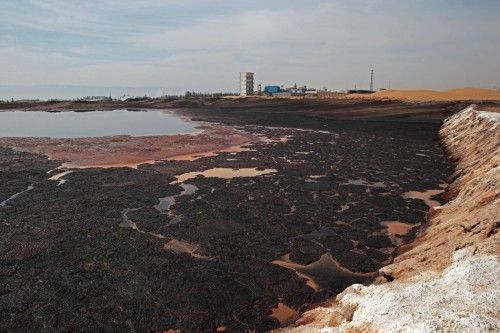In today's podcast, communities along the Yellow River valley wonder when a line in the sand will be drawnover toxic fumes spewing from mining dump sites.
在今天的播客中,讓黃河流域的居民感到驚奇的是沙地飄滿了礦業廢物處理廠中所排出的有毒氣體。

Groggy with steady wafts of noxious fumes, many residents in villages dotted along the Tengger Desert havemade complaints about the health risks associated with pollution in nearby wastewater ponds. A report first made by Beijing News raised the issue possible environmental violations committed by the mining companies that built the ponds. In October, President Xi Jinping signed a document that ordered local government officials in areas with factory-waste evaporation ponds to protect the environment and if necessary launch clean-up campaigns. While ponds near the Tengger Desert were closed and filled following central government mandates, a Caixin investigation has found that some 100 evaporation pond sites across northwest China continue to effectively be used as dumping sites. Pollution monitoring of drinking water in nearby sites has given major cause for concern. A 2013 study by the All-China Environment Federation, found excessive levels of phenol, sulfides and bacteria in drinking wells near the Tengger Industrial Park.
許多居民遭到了有毒氣體的迫害,居住在騰格里沙漠地區的居民抱怨廢水處理池污染所引發的健康問題。首先報道這一事件的媒體是北京新聞,他們認為建造水池的礦業公司可能違反了環境規章制度。10月份,習近平主席簽署了要求工業廢物蒸汽池的相關政府保護環境的文件,如果有必要的話將會發起清理行動。中央政府的指令下達以后,騰格里沙漠周邊的廢水處理池已經關閉,并得到了填埋,財新的調查發現在中國的西北部地區仍然有大約100處仍在利用的廢水蒸汽池。而周邊地區的引用水污染監控卻讓人們憂心忡忡。中華環保聯合會在2013年的研究發現,騰格里工業園附近的引用水中含有超量的石碳酸、硫化物以及細菌物質。
For Caixin Online, this is Diana Bates.
這是戴安娜·貝茨為您帶來的財新新聞報道。
譯文屬可可英語原創,未經允許,不得轉載。











